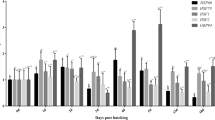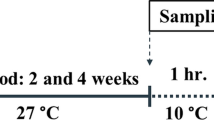Abstract
Larvae of the brine shrimp Artemia franciscana serve as important feed in fish and shellfish larviculture; however, they are subject to bacterial diseases that devastate entire populations and consequently hinder their use in aquaculture. Exposure to abiotic stress was shown previously to shield Artemia larvae against infection by pathogenic Vibrio, with the results suggesting a mechanistic role for heat shock protein 70. In the current report, combined hypothermic/hyperthermic shock followed by recovery at ambient temperature induced Hsp70 synthesis in Artemia larvae. Thermotolerance was also increased as was protection against infection by Vibrio campbellii, the latter indicated by reduced mortality and lower bacterial load in challenge tests. Resistance to Vibrio improved in the face of declining body mass as demonstrated by measurement of ash-free dry weight. Hypothermic stress only and acute osmotic insult did not promote Hsp70 expression and thermotolerance in Artemia larvae nor was resistance to Vibrio challenge augmented. The data support a causal link between Hsp70 accumulation induced by abiotic stress and enhanced resistance to infection by V. campbellii, perhaps via stimulation of the Artemia immune system. This possibility is now under investigation, and the work may reveal fundamental properties of crustacean immunity. Additionally, the findings are important in aquaculture where development of procedures to prevent bacterial infection of feed stock such as Artemia larvae is a priority.






Similar content being viewed by others
References
Avendaño-Herrera R, Magariños B, Irgang R, Toranzo AE (2006) Use of hydrogen peroxide against the fish pathogen Tenacibaculum maritimum and its effect on infected turbot (Scophthalmus maximus). Aquaculture 257:104–110
Asea A, Kraeft SK, Kurt-Jones EA, Stevenson MA, Chen LB, Finberg RW, Koo GC, Calderwood SK (2000) HSP70 stimulates cytokine production through a CD14-dependant pathway, demonstrating its dual role as a chaperone and cytokine. Nat Med 6:435–442
Asea A, Rehli M, Kabingu E, Boch JA, Bare O, Auron PE, Stevenson MA, Calderwood SK (2002) Novel signal transduction pathway utilized by extracellular HSP70: role of Toll-like receptor (TLR) 2 and TLR4. J Biol Chem 277:15028–15034
Basu N, Todgham AE, Ackerman PA, Bibeau MR, Nakano K, Schulte PM, Iwama GK (2002) Heat shock protein genes and their functional significance in fish. Gene 295:173–183
Browne RA, Wanigasekera G (2000) Combined effects of salinity and temperature on survival and reproduction of five species of Artemia. J Exp Mar Biol Ecol 244:29–44
Campisi J, Fleshner M (2003) The role of extracellular Hsp72 in acute stress-induced potentiation of innate immunity in physically active rats. J Appl Physiol 94:43–52
Clegg JS, Jackson SA, Hoa NV, Sorgeloos P (2000a) Thermal resistance, developmental rate and heat shock proteins in Artemia franciscana, from San Francisco Bay and Southern Vietnam. J Exp Mar Biol Ecol 252:85–96
Clegg JS, Jackson SA, Popov VI (2000b) Long-term anoxia in encysted embryos of the crustacean, Artemia franciscana: viability, ultrastructure and stress proteins. Cell Tissue Res 301:433–446
Clegg JS, Trotman CNA (2002) Physiological and biochemical aspects of Artemia ecology. In: Abatzopoulos ThJ, Beardmore JA, Clegg JS, Sorgeloos P (eds) Artemia: basic and applied biology. Kluwer, Dordrecht, pp 129–170
Chen W, Syldath U, Bellmann K, Burkart V, Kolb W (1999) Human 60-kDa heat-shock protein: a danger signal to the innate immune system. J Immunol 162:3212–3219
Cheng W, Wang LU, Chen JC (2005) Effect of water temperature on the immune response of white shrimp Litopenaeus vamnnamei to Vibrio alginolyticus. Aquaculture 250:592–601
Chrousos GP, Gold PW (1992) The concepts of stress and stress system disorders. Overview of physical and behavioural homeostasis. J Am Med Assoc 267:1244–1252
Das P, Gupta A, Manna SK (2005) Heat shock protein 70 expression in different tissues of Cirrhinus mrigala (Ham.) following heat stress. Aquaculture Res 36:525–529
Defoirdt T, Halet D, Sorgeloos P, Bossier P, Verstraete W (2006) Short-chain fatty acids protect gnotobiotic Artemia franciscana from pathogenic Vibrio campbellii. Aquaculture 261:804–808
Delaney MA, Klesius PH (2004) Hypoxic conditions induce Hsp70 production in blood, brain and head kidney of juvenile Nile tilapia Oreochromis niloticus (L.). Aquaculture 236:633–644
de la Vega E, Hall MR, Degnan BM, Wilson KJ (2006) Short-term hyperthermic treatment of Penaeus monodon increases expression of heat shock protein 70 (HSP70) and reduces replication of gill associated virus (GAV). Aquaculture 253:82–90
DuBeau SF, Pan F, Tremblay GC, Bradley TM (1998) Thermal shock of salmon in vivo induces the heat shock protein hsp 70 and confers protection against osmotic shock. Aquaculture 168:311–323
Frankenberg MM, Jackson SA, Clegg JS (2000) The heat shock response of adult Artemia franciscana. J Thermal Biol 25:481–490
Harris RBS, Zhou J, Youngblood BD, Rybkin II, Smagin GN, Ryan DH (1998) Effect of repeated stress on body weight and body composition of rats fed low- and high-fat diets. Am J Physiol Regul Integr Comp Physiol 275:1928–1938
Jean S, De Jong L, Moreau X (2004) Chaetognaths: a useful model for studying heat shock proteins. Effect of wound healing. J Exp Mar Biol Ecol 312:319–332
Johnson JD, Fleshner M (2006) Releasing signals, secretory pathways, and immune function of endogenous extracellular heat shock protein 72. J Leukoc Biol 79:425–434
Jolly C, Morimoto RI (1999) Stress and the cell nucleus: dynamics of gene expression and structural reorganization. Gene 7:261–270
Laemmli UK (1970) Cleavage of structural proteins during assembly of the head of bacteriophage T4. Nature 227:680–685
Le Moullac G, Soyez C, Saulnier D, Ansquer D, Avarre JC, Levy P (1998) Effect of hypoxic stress on the immune response and the resistance to vibriosis of the shrimp Penaeus stylirostris. Fish Shellfish Immunol 8:621–629
Liang P, MacRae TH (1999) The synthesis of a small heat shock/a-crystallin protein in Artemia and its relationship to stress tolerance during development. Dev Biol 207:445–456
Liao CM, Chang CF, Yeh CH, Chen SC, Chiang KC, Chio CP, Chou BYH, Jou LJ, Lien GW, Lin CM, Shen HH, Wu GD (2006) Metal stresses affect the population dynamics of disease transmission in aquaculture species. Aquaculture 257:321–332
Lindquist S (1992) Heat-shock proteins and stress tolerance in microorganisms. Curr Opin Genet Dev 2:748–755
Lindquist S, Craig EA (1988) The heat-shock proteins. Ann Rev Gen 22:631–677
Livingstone DR (1985) Biochemical measurements. In: Bayne BL (ed) The effects of stress and pollution on marine animals. Praeger, NY, pp 81–132
Marques A, Dhont J, Sorgeloos P, Bossier P (2004a) Evaluation of different yeast cell wall mutants and microalgae strains as feed for gnotobiotically grown brine shrimp Artemia franciscana. J Exp Mar Biol Ecol 321:115–136
Marques A, Dhont J, Sorgeloos P, Bossier P (2006a) Immunostimulatory nature of β-glucans and baker’s yeast in the challenge test of Artemia. Fish Shellfish Immunol 20:682–692
Marques A, Thanh TH, Sorgeloos P, Bossier P (2006b) Use of microalgae and bacteria to enhance protection of gnotobiotic Artemia against different pathogens. Aquaculture 258:116–126
Marques A, Thanh TH, Verstraete W, Dhont J, Sorgeloos P, Bossier P (2006c) Use of selected bacteria and yeast to protect gnotobiotic Artemia against different pathogens. J Exp Mar Biol Ecol 334:20–30
Ménoret A (2004) Purification of recombinant and endogenous HSP70s. Methods 32:7–12
Merchie G (1996) Use of nauplii and meta-nauplii. In: Lavens P, Sorgeloos P (eds) Manual on the production and use of live food for aquaculture. FAO Fisheries Technical Paper. No. 361, Rome, pp 137–163
Mercier L, Palacios E, Campa-Córdova AI, Tovar-Ramírez D, Hernández-Herrera R, Racotta IS (2006) Metabolic and immune responses in Pacific whiteleg shrimp Litopenaeus vannamei exposed to a repeated handling stress. Aquaculture 258:633–640
Miller D, McLennan AG (1988a) The heat shock response of the cryptobiotic brine shrimp Artemia—I. Thermotolerance. J Thermal Biol 13:119–123
Miller D, McLennan AG (1988b) The heat shock response of the cryptobiotic brine shrimp Artemia—II. Heat shock proteins. J Thermal Biol 13:125–134
Panjwani NN, Popova L, Srivastava PK (2002) Heat shock proteins gp96 and hsp70 activate the release of nitric oxide by APCs. J Immunol 168:2997–3003
Parsell DA, Lindquist S (1994) Heat shock proteins and stress tolerance. In: Morimoto RI, Tissieres A, Georgopoulos C (eds.) The biology of heat shock proteins and molecular chaperones. Cold Spring Harbor Laboratory Press, NY, pp 457–494
Pockley AG (2003) Heat shock proteins as regulators of the immune response. Lancet 362:469–476
Robert J (2003) Evolution of heat shock protein and immunity. Dev Comp Immunol 27:449–464
Singh V, Aballay A (2006a) Heat-shock transcription factor (HSF)-1 pathway required for Caenorhabditis elegans immunity. Proc Natl Acad Sci USA 103:13092–13097
Singh V, Aballay A (2006b) Heat-shock and gene activation of HSF-1 enhance immunity to bacteria. Cell Cycle 21:2443–2446
Song LS, Wu LT, Ni DJ, Chang YQ, Xu W, Xing KZ (2006) The cDNA cloning and mRNA expression of heat shock protein 70 gene in the haemocytes of bay scallop (Argopecten irradians, Lamarck 1819) responding to bacteria challenge and naphthalin stress. Fish Shellfish Immunol 21:335–345
Sorgeloos P, Lavens P, Léger P, Tackaert W, Versichele D (1986) Manual for the culture and use of brine shrimp Artemia in aquaculture. Artemia Reference Center Faculty of Agriculture State University of Ghent, Ghent, Belgium
Sørensen JG, Loeschcke V (2001) Larval crowding in Drosophila melanogaster induces hsp70 expression, and leads to increased adult longevity and adult thermal stress resistance. J Insect Physiol 47:1301–1307
Steinert SA, Pickwell GV (1993) Induction of hsp70 proteins in mussels by ingestion of tributyltin. Responses of marine organisms to pollutants. Part 2. Environ Res 35:89–93
Sung YY, Van Damme EJM, Sorgeloos P, Bossier P (2007) Non-lethal heat shock protects gnotobiotic Artemia franciscana larvae against virulent Vibrios. Fish Shellfish Immunol 22:318–326
Todgham AE, Schulte PM, Iwama GK (2005) Cross-tolerance in the tidepool sculpin: the role of heat shock proteins. Physiol Biochem Zool 78:133–144
Vabulas RM, Ahmad-Nejad P, Ghose S, Kirschning CJ, Issels RD, Wagner H (2002) HSP70 as endogenous stimulus of the Toll/interleukin-1 receptor signal pathway. J Biol Chem 277:15107–15112
Van Stappen G (2002) Zoogeography. In: Abatzopoulos ThJ, Beardmore JA, Clegg JS, Sorgeloos P (eds) Artemia: basic and applied biology. Kluwer, Dordrecht, pp 171–224
Varsamos S, Flik G, Pepin JF, Wendelaar BSE, Breuil G (2006) Husbandry stress during early life stages affects the stress response and health status of juvenile sea bass, Dicentrarchus labrax. Fish Shellfish Immunol 20:83–96
Visintin A, Mazzoni A, Spitzer JH, Wyllie DH, Dower SK, Segal DM (2001) Regulation of Toll-like receptors in human monocytes and dendritic cells. J Immunol 166:249–255
Volker U, Mach R, Schmid R, Hecker M (1992) Stress proteins and cross-protection by heat shock and salt stress in Bacillus subtilis. J Gen Microbiol 138:2125–2135
Wang FI, Chen JC (2006a) Effect of salinity on the immune response of tiger shrimp Penaeus monodon and its susceptibility to Photobacterium damselae subsp. damselae. Fish Shellfish Immunol 20:671–681
Wang FI, Chen JC (2006b) The immune response of tiger shrimp Penaeus monodon and its susceptibility to Photobacterium damselae subsp. damselae under temperature stress. Aquaculture 258:34–41
Acknowledgments
This work was supported by Universiti Malaysia Terengganu (UMT; formerly known as University College of Science and Technology Malaysia, KUSTEM) through a doctoral grant to YYS and research funding supported by the Belgian Foundation for Scientific Research (FWO) through the project “Nutritional and immunostimulatory characteristics of isogenic yeast mutants in Artemia” (1.5.125.04).
Author information
Authors and Affiliations
Corresponding author
Rights and permissions
About this article
Cite this article
Sung, Y.Y., Pineda, C., MacRae, T.H. et al. Exposure of gnotobiotic Artemia franciscana larvae to abiotic stress promotes heat shock protein 70 synthesis and enhances resistance to pathogenic Vibrio campbellii . Cell Stress and Chaperones 13, 59–66 (2008). https://doi.org/10.1007/s12192-008-0011-y
Received:
Revised:
Accepted:
Published:
Issue Date:
DOI: https://doi.org/10.1007/s12192-008-0011-y




